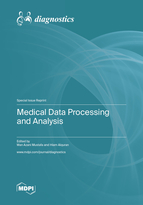Medical Data Processing and Analysis
A special issue of Diagnostics (ISSN 2075-4418). This special issue belongs to the section "Machine Learning and Artificial Intelligence in Diagnostics".
Deadline for manuscript submissions: closed (24 March 2023) | Viewed by 32506
Special Issue Editors
2. Advanced Computing (AdvComp), Centre of Excellence (CoE), Universiti Malaysia Perlis, Arau 02600, Perlis, Malaysia
Interests: biomedical imaging; image processing; digital signal processing; artificial intelligence; feature extraction; recognition and classification
Special Issues, Collections and Topics in MDPI journals
Interests: image processing; digital signal processing; artificial intelligence
Special Issues, Collections and Topics in MDPI journals
Special Issue Information
Dear Colleagues,
Medical data can be defined as obtaining information from patients (such as signals, images, sounds, chemical components and their concentration, body temperature, respiratory rate, blood pressure, and different treatment measurements) to quantify the patient’s status and the disease stage. Computer-aided diagnostic (CAD) systems use classical image processing, computer vision, machine learning, and deep learning methods for image analysis. Using image classification or segmentation algorithms, they find a region of interest (ROI) pointing to a specific location within the given image or the outcome of interest in the form of a label pointing to a diagnosis or prognosis. Computer science, with the evolution of artificial intelligence and machine learning techniques, facilitates the modeling and interpretation of results from carrying out measurements, experiments, and observations. Employing technological tools for collection, processing, and analysis will incorporate understanding the patient’s status and developing the treatment plan. Achieving highly accurate models requires a huge dataset. This issue can be solved by having enough knowledge around medical data processing and its analysis.
This Special Issue of the journal Diagnostics provides you with the opportunity to disseminate the findings of your research that highlight innovative aspects of biomedical data processing and/or modeling in healthcare. Applications such as patient monitoring, disease diagnosis and progression, patient rehabilitation, and medical image analysis are encouraged. It is expected that you clearly indicate the novel aspects of signal processing or modeling that assisted you in solving your problem.
Dr. Wan Azani Mustafa
Dr. Hiam Alquran
Guest Editors
Manuscript Submission Information
Manuscripts should be submitted online at www.mdpi.com by registering and logging in to this website. Once you are registered, click here to go to the submission form. Manuscripts can be submitted until the deadline. All submissions that pass pre-check are peer-reviewed. Accepted papers will be published continuously in the journal (as soon as accepted) and will be listed together on the special issue website. Research articles, review articles as well as short communications are invited. For planned papers, a title and short abstract (about 100 words) can be sent to the Editorial Office for announcement on this website.
Submitted manuscripts should not have been published previously, nor be under consideration for publication elsewhere (except conference proceedings papers). All manuscripts are thoroughly refereed through a single-blind peer-review process. A guide for authors and other relevant information for submission of manuscripts is available on the Instructions for Authors page. Diagnostics is an international peer-reviewed open access semimonthly journal published by MDPI.
Please visit the Instructions for Authors page before submitting a manuscript. The Article Processing Charge (APC) for publication in this open access journal is 2600 CHF (Swiss Francs). Submitted papers should be well formatted and use good English. Authors may use MDPI's English editing service prior to publication or during author revisions.
Keywords
- biomedical image processing
- biomedical signal processing
- medical data analysis
- pattern recognition
- health system
- bioinformatics
- mental health
- biomedical systems
- biomedical physics
- decision support system
- diagnostic aid
- ai-based screening system
- medical image and signal classification
- biomedical image retrieval
- medical image annotation
- biomedical image summarization
- cancer diagnosis
- medical images
- machine learning
- deep learning
- artificial intelligence
Related Special Issue
- Medical Data Processing and Analysis—2nd Edition in Diagnostics (9 articles)








